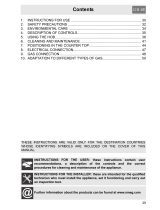
Cleaning and maintenance
55
EN
4 Cleaning and maintenance
4.1 Instructions
4.2 Cleaning the appliance
To keep the surfaces in good condition,
they should be cleaned regularly after use.
Let them cool first.
Ordinary daily cleaning
Always use only specific products that do
not contain abrasives or chlorine-based
acids.
Pour the product onto a damp cloth and
wipe the surface, rinse thoroughly and dry
with a soft cloth or a microfibre cloth.
Food stains or residues
Do not use metallic sponges or sharp
scrapers as they will damage the surfaces.
Use ordinary non-abrasive products with
the aid of wooden or plastic utensils if
necessary. Rinse thoroughly and dry with a
soft cloth or a microfibre cloth.
Do not allow residues of sugary foods (such
as jam) to set inside the oven. If left to set for
too long, they might damage the enamel
lining of the oven.
Cooking hob pan stands
Remove the pan stands and clean them with
lukewarm water and non-abrasive
detergent. Make sure to remove any
encrustations. Dry them thoroughly and
return them to the hob.
Flame-spreader crowns and burner caps
For easier cleaning, the flame-spreader
crowns and the burner caps can be
removed. Wash them in hot water and non-
abrasive detergent. Carefully remove any
encrustation, then wait until they are
perfectly dry. Refit the flame-spreader
crowns making sure that they are correctly
positioned in their housings with their
respective burner caps.
Improper use
Risk of damage to surfaces
• Do not use steam jets for cleaning the
appliance.
• Do not use cleaning products containing
chlorine, ammonia or bleach on steel
parts or parts with metallic finishes on the
surface (e.g. anodizing, nickel- or
chromium-plating).
• Do not use abrasive or corrosive
detergents on glass parts (e.g. powder
products, stain removers and metallic
sponges).
• Do not use rough or abrasive materials
or sharp metal scrapers.
• Do not wash the removable
components such as the hob pan stands,
flame-spreader crowns and burner caps
in a dishwasher.
Continuous contact between the
pan stands and the flame can
cause modifications to the enamel
over time in those parts exposed to
heat. This is a completely natural
phenomenon which has no effect
on the operation of this
component.




















